Wireless Networking Concepts Report: Data Encryption and IoT
VerifiedAdded on 2021/06/15
|8
|1687
|19
Report
AI Summary
This report delves into various aspects of wireless networking. It begins by comparing and contrasting three data encryption standards (AES, RSA, and 3-DES) used in WiMAX networks, analyzing their strengths and weaknesses in terms of speed, power consumption, and algorithm complexity. The report then examines the process of traffic coordination in shared wireless mediums, discussing protocols like RTS/CTS and CSMA/CA and methods to reduce collisions. Furthermore, it provides a critical reflection on two research papers related to the Internet of Things (IoT), focusing on the design and simulation of ZigBee transmitters and the evolution from Intranets of Things to a future Internet of Things, emphasizing challenges like heterogeneity and the importance of IP addresses. The report incorporates discussions on energy harvest, digital design and Verilog-HDL simulation of Bit-to-Symbol block and Cyclic Redundancy Check of ZigBee transmitter.
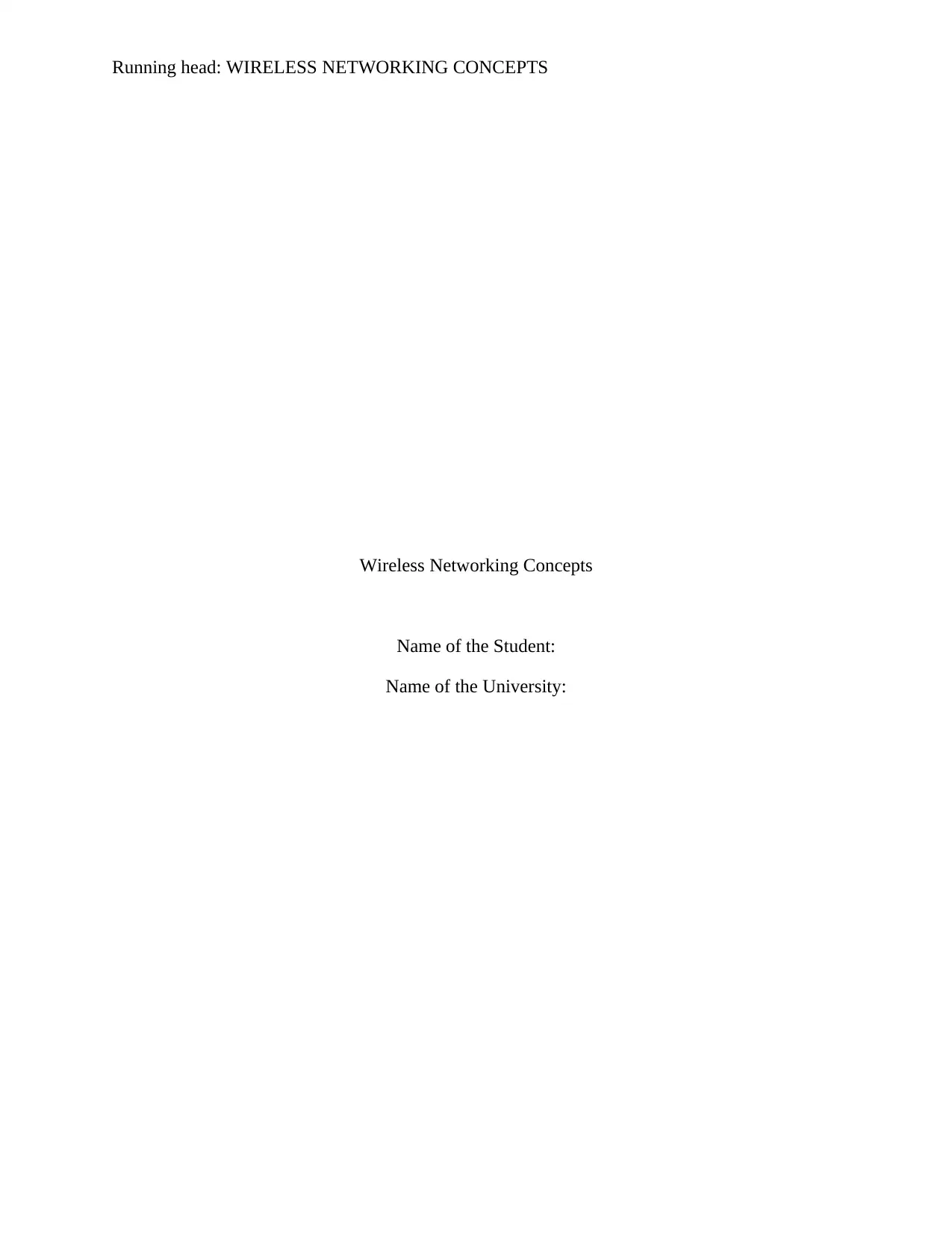
Running head: WIRELESS NETWORKING CONCEPTS
Wireless Networking Concepts
Name of the Student:
Name of the University:
Wireless Networking Concepts
Name of the Student:
Name of the University:
Paraphrase This Document
Need a fresh take? Get an instant paraphrase of this document with our AI Paraphraser
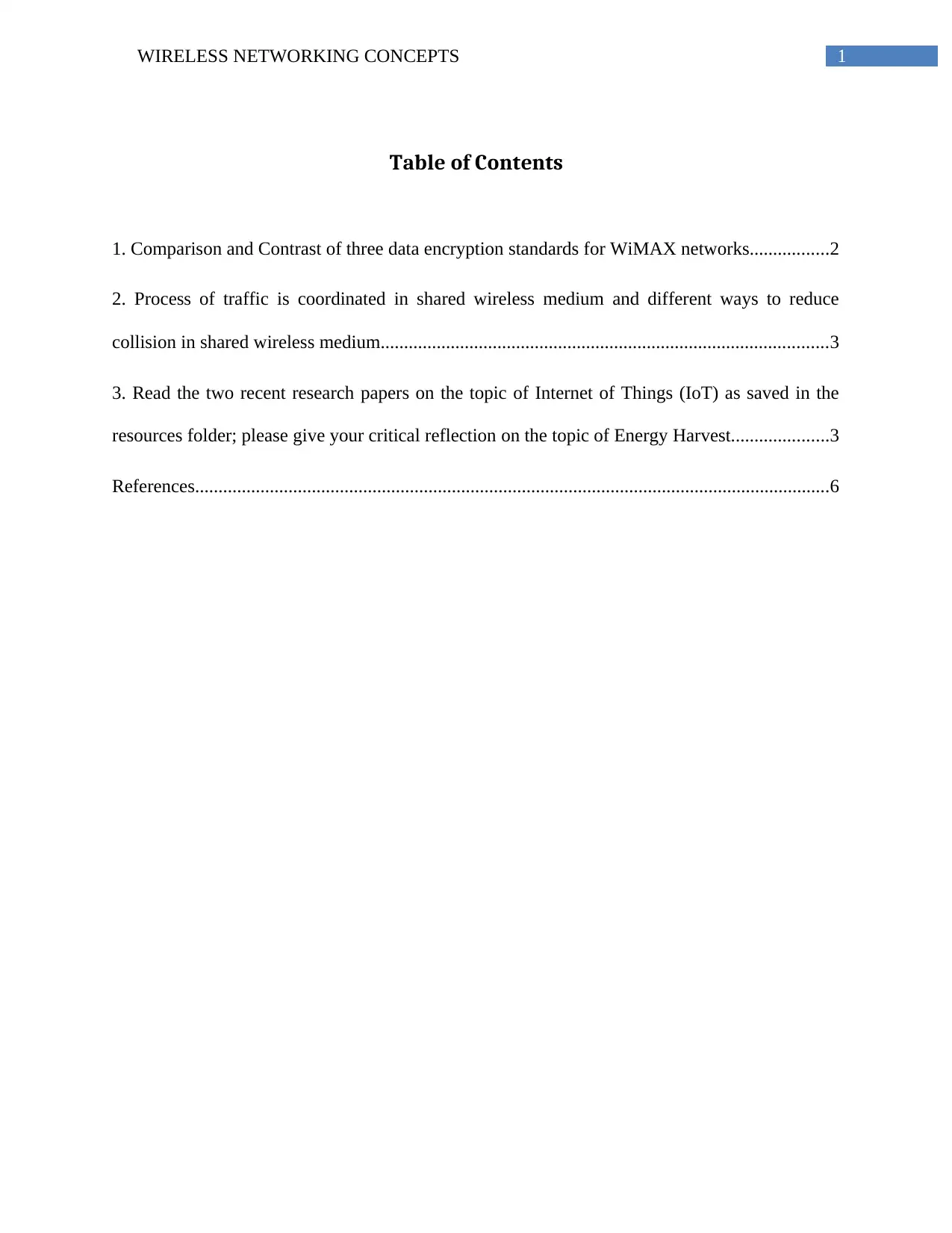
1WIRELESS NETWORKING CONCEPTS
Table of Contents
1. Comparison and Contrast of three data encryption standards for WiMAX networks.................2
2. Process of traffic is coordinated in shared wireless medium and different ways to reduce
collision in shared wireless medium................................................................................................3
3. Read the two recent research papers on the topic of Internet of Things (IoT) as saved in the
resources folder; please give your critical reflection on the topic of Energy Harvest.....................3
References........................................................................................................................................6
Table of Contents
1. Comparison and Contrast of three data encryption standards for WiMAX networks.................2
2. Process of traffic is coordinated in shared wireless medium and different ways to reduce
collision in shared wireless medium................................................................................................3
3. Read the two recent research papers on the topic of Internet of Things (IoT) as saved in the
resources folder; please give your critical reflection on the topic of Energy Harvest.....................3
References........................................................................................................................................6
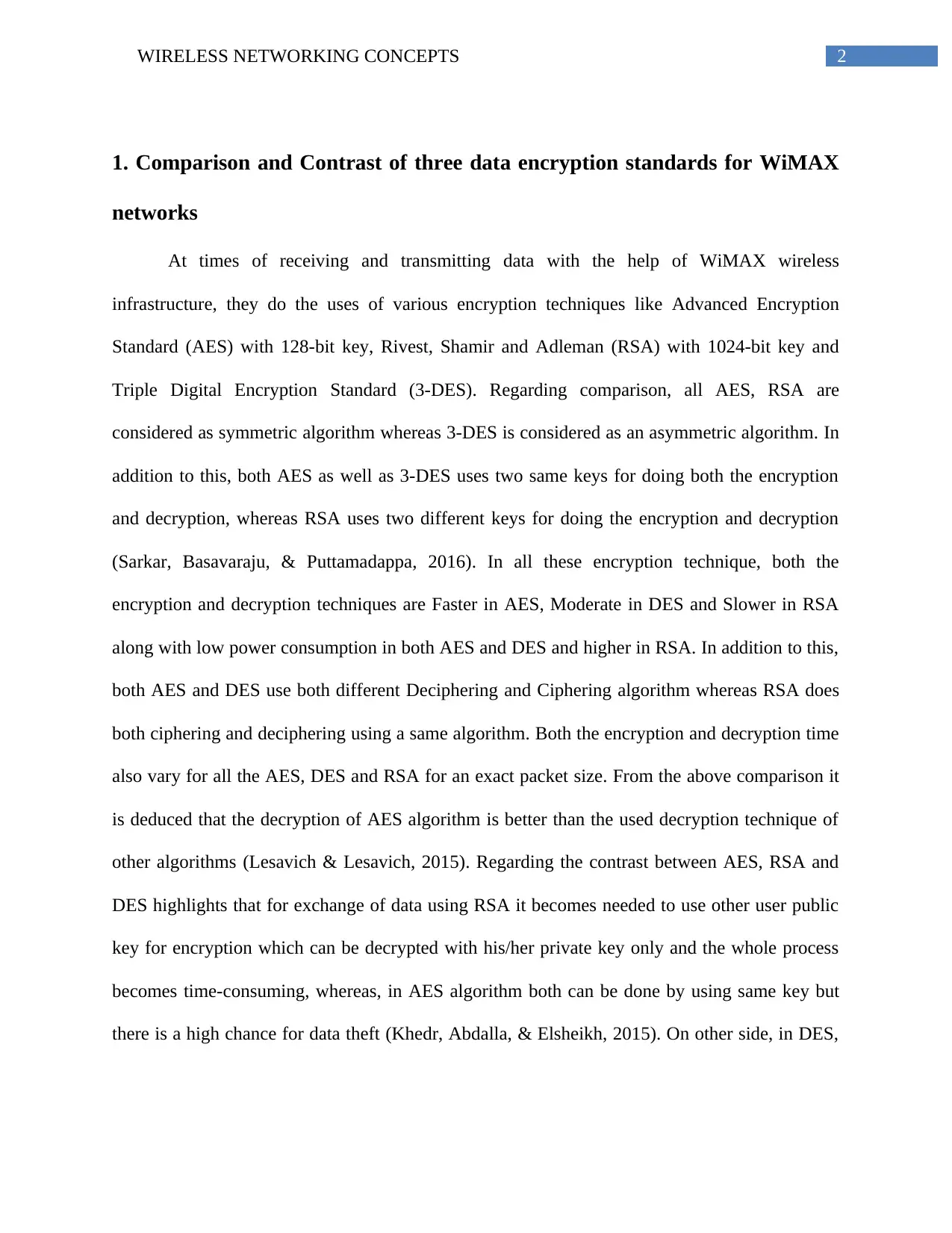
2WIRELESS NETWORKING CONCEPTS
1. Comparison and Contrast of three data encryption standards for WiMAX
networks
At times of receiving and transmitting data with the help of WiMAX wireless
infrastructure, they do the uses of various encryption techniques like Advanced Encryption
Standard (AES) with 128-bit key, Rivest, Shamir and Adleman (RSA) with 1024-bit key and
Triple Digital Encryption Standard (3-DES). Regarding comparison, all AES, RSA are
considered as symmetric algorithm whereas 3-DES is considered as an asymmetric algorithm. In
addition to this, both AES as well as 3-DES uses two same keys for doing both the encryption
and decryption, whereas RSA uses two different keys for doing the encryption and decryption
(Sarkar, Basavaraju, & Puttamadappa, 2016). In all these encryption technique, both the
encryption and decryption techniques are Faster in AES, Moderate in DES and Slower in RSA
along with low power consumption in both AES and DES and higher in RSA. In addition to this,
both AES and DES use both different Deciphering and Ciphering algorithm whereas RSA does
both ciphering and deciphering using a same algorithm. Both the encryption and decryption time
also vary for all the AES, DES and RSA for an exact packet size. From the above comparison it
is deduced that the decryption of AES algorithm is better than the used decryption technique of
other algorithms (Lesavich & Lesavich, 2015). Regarding the contrast between AES, RSA and
DES highlights that for exchange of data using RSA it becomes needed to use other user public
key for encryption which can be decrypted with his/her private key only and the whole process
becomes time-consuming, whereas, in AES algorithm both can be done by using same key but
there is a high chance for data theft (Khedr, Abdalla, & Elsheikh, 2015). On other side, in DES,
1. Comparison and Contrast of three data encryption standards for WiMAX
networks
At times of receiving and transmitting data with the help of WiMAX wireless
infrastructure, they do the uses of various encryption techniques like Advanced Encryption
Standard (AES) with 128-bit key, Rivest, Shamir and Adleman (RSA) with 1024-bit key and
Triple Digital Encryption Standard (3-DES). Regarding comparison, all AES, RSA are
considered as symmetric algorithm whereas 3-DES is considered as an asymmetric algorithm. In
addition to this, both AES as well as 3-DES uses two same keys for doing both the encryption
and decryption, whereas RSA uses two different keys for doing the encryption and decryption
(Sarkar, Basavaraju, & Puttamadappa, 2016). In all these encryption technique, both the
encryption and decryption techniques are Faster in AES, Moderate in DES and Slower in RSA
along with low power consumption in both AES and DES and higher in RSA. In addition to this,
both AES and DES use both different Deciphering and Ciphering algorithm whereas RSA does
both ciphering and deciphering using a same algorithm. Both the encryption and decryption time
also vary for all the AES, DES and RSA for an exact packet size. From the above comparison it
is deduced that the decryption of AES algorithm is better than the used decryption technique of
other algorithms (Lesavich & Lesavich, 2015). Regarding the contrast between AES, RSA and
DES highlights that for exchange of data using RSA it becomes needed to use other user public
key for encryption which can be decrypted with his/her private key only and the whole process
becomes time-consuming, whereas, in AES algorithm both can be done by using same key but
there is a high chance for data theft (Khedr, Abdalla, & Elsheikh, 2015). On other side, in DES,
⊘ This is a preview!⊘
Do you want full access?
Subscribe today to unlock all pages.

Trusted by 1+ million students worldwide
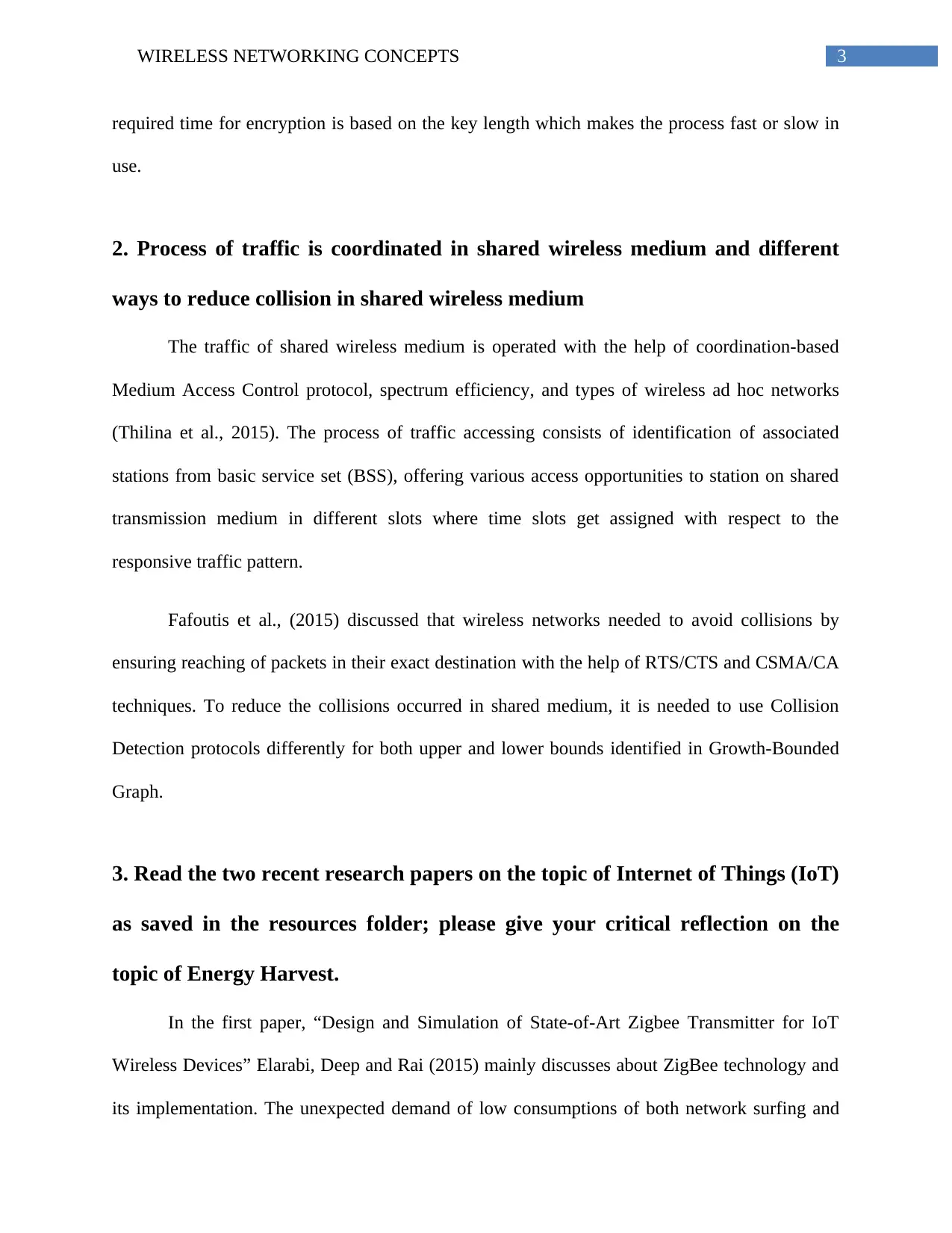
3WIRELESS NETWORKING CONCEPTS
required time for encryption is based on the key length which makes the process fast or slow in
use.
2. Process of traffic is coordinated in shared wireless medium and different
ways to reduce collision in shared wireless medium
The traffic of shared wireless medium is operated with the help of coordination-based
Medium Access Control protocol, spectrum efficiency, and types of wireless ad hoc networks
(Thilina et al., 2015). The process of traffic accessing consists of identification of associated
stations from basic service set (BSS), offering various access opportunities to station on shared
transmission medium in different slots where time slots get assigned with respect to the
responsive traffic pattern.
Fafoutis et al., (2015) discussed that wireless networks needed to avoid collisions by
ensuring reaching of packets in their exact destination with the help of RTS/CTS and CSMA/CA
techniques. To reduce the collisions occurred in shared medium, it is needed to use Collision
Detection protocols differently for both upper and lower bounds identified in Growth-Bounded
Graph.
3. Read the two recent research papers on the topic of Internet of Things (IoT)
as saved in the resources folder; please give your critical reflection on the
topic of Energy Harvest.
In the first paper, “Design and Simulation of State-of-Art Zigbee Transmitter for IoT
Wireless Devices” Elarabi, Deep and Rai (2015) mainly discusses about ZigBee technology and
its implementation. The unexpected demand of low consumptions of both network surfing and
required time for encryption is based on the key length which makes the process fast or slow in
use.
2. Process of traffic is coordinated in shared wireless medium and different
ways to reduce collision in shared wireless medium
The traffic of shared wireless medium is operated with the help of coordination-based
Medium Access Control protocol, spectrum efficiency, and types of wireless ad hoc networks
(Thilina et al., 2015). The process of traffic accessing consists of identification of associated
stations from basic service set (BSS), offering various access opportunities to station on shared
transmission medium in different slots where time slots get assigned with respect to the
responsive traffic pattern.
Fafoutis et al., (2015) discussed that wireless networks needed to avoid collisions by
ensuring reaching of packets in their exact destination with the help of RTS/CTS and CSMA/CA
techniques. To reduce the collisions occurred in shared medium, it is needed to use Collision
Detection protocols differently for both upper and lower bounds identified in Growth-Bounded
Graph.
3. Read the two recent research papers on the topic of Internet of Things (IoT)
as saved in the resources folder; please give your critical reflection on the
topic of Energy Harvest.
In the first paper, “Design and Simulation of State-of-Art Zigbee Transmitter for IoT
Wireless Devices” Elarabi, Deep and Rai (2015) mainly discusses about ZigBee technology and
its implementation. The unexpected demand of low consumptions of both network surfing and
Paraphrase This Document
Need a fresh take? Get an instant paraphrase of this document with our AI Paraphraser
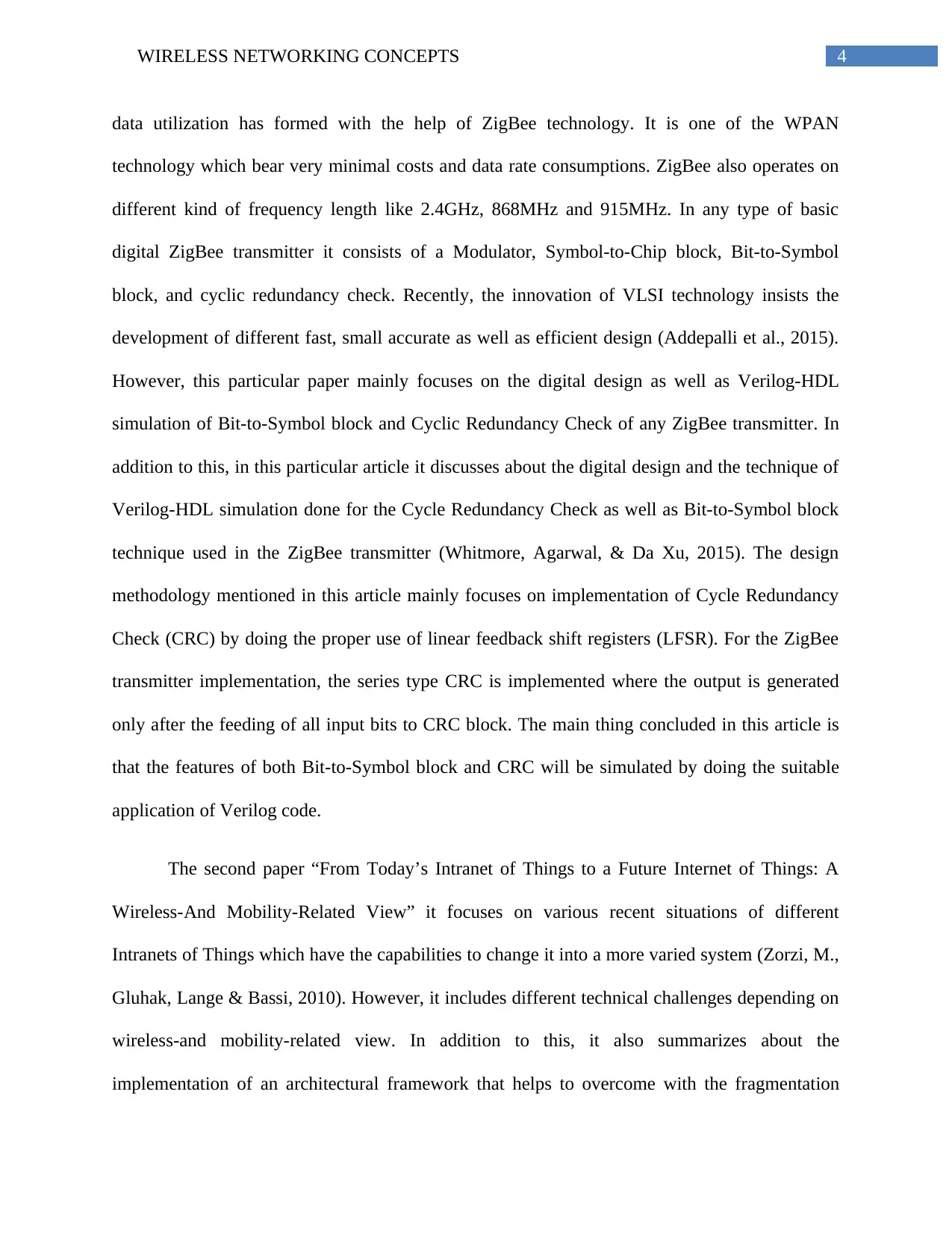
4WIRELESS NETWORKING CONCEPTS
data utilization has formed with the help of ZigBee technology. It is one of the WPAN
technology which bear very minimal costs and data rate consumptions. ZigBee also operates on
different kind of frequency length like 2.4GHz, 868MHz and 915MHz. In any type of basic
digital ZigBee transmitter it consists of a Modulator, Symbol-to-Chip block, Bit-to-Symbol
block, and cyclic redundancy check. Recently, the innovation of VLSI technology insists the
development of different fast, small accurate as well as efficient design (Addepalli et al., 2015).
However, this particular paper mainly focuses on the digital design as well as Verilog-HDL
simulation of Bit-to-Symbol block and Cyclic Redundancy Check of any ZigBee transmitter. In
addition to this, in this particular article it discusses about the digital design and the technique of
Verilog-HDL simulation done for the Cycle Redundancy Check as well as Bit-to-Symbol block
technique used in the ZigBee transmitter (Whitmore, Agarwal, & Da Xu, 2015). The design
methodology mentioned in this article mainly focuses on implementation of Cycle Redundancy
Check (CRC) by doing the proper use of linear feedback shift registers (LFSR). For the ZigBee
transmitter implementation, the series type CRC is implemented where the output is generated
only after the feeding of all input bits to CRC block. The main thing concluded in this article is
that the features of both Bit-to-Symbol block and CRC will be simulated by doing the suitable
application of Verilog code.
The second paper “From Today’s Intranet of Things to a Future Internet of Things: A
Wireless-And Mobility-Related View” it focuses on various recent situations of different
Intranets of Things which have the capabilities to change it into a more varied system (Zorzi, M.,
Gluhak, Lange & Bassi, 2010). However, it includes different technical challenges depending on
wireless-and mobility-related view. In addition to this, it also summarizes about the
implementation of an architectural framework that helps to overcome with the fragmentation
data utilization has formed with the help of ZigBee technology. It is one of the WPAN
technology which bear very minimal costs and data rate consumptions. ZigBee also operates on
different kind of frequency length like 2.4GHz, 868MHz and 915MHz. In any type of basic
digital ZigBee transmitter it consists of a Modulator, Symbol-to-Chip block, Bit-to-Symbol
block, and cyclic redundancy check. Recently, the innovation of VLSI technology insists the
development of different fast, small accurate as well as efficient design (Addepalli et al., 2015).
However, this particular paper mainly focuses on the digital design as well as Verilog-HDL
simulation of Bit-to-Symbol block and Cyclic Redundancy Check of any ZigBee transmitter. In
addition to this, in this particular article it discusses about the digital design and the technique of
Verilog-HDL simulation done for the Cycle Redundancy Check as well as Bit-to-Symbol block
technique used in the ZigBee transmitter (Whitmore, Agarwal, & Da Xu, 2015). The design
methodology mentioned in this article mainly focuses on implementation of Cycle Redundancy
Check (CRC) by doing the proper use of linear feedback shift registers (LFSR). For the ZigBee
transmitter implementation, the series type CRC is implemented where the output is generated
only after the feeding of all input bits to CRC block. The main thing concluded in this article is
that the features of both Bit-to-Symbol block and CRC will be simulated by doing the suitable
application of Verilog code.
The second paper “From Today’s Intranet of Things to a Future Internet of Things: A
Wireless-And Mobility-Related View” it focuses on various recent situations of different
Intranets of Things which have the capabilities to change it into a more varied system (Zorzi, M.,
Gluhak, Lange & Bassi, 2010). However, it includes different technical challenges depending on
wireless-and mobility-related view. In addition to this, it also summarizes about the
implementation of an architectural framework that helps to overcome with the fragmentation
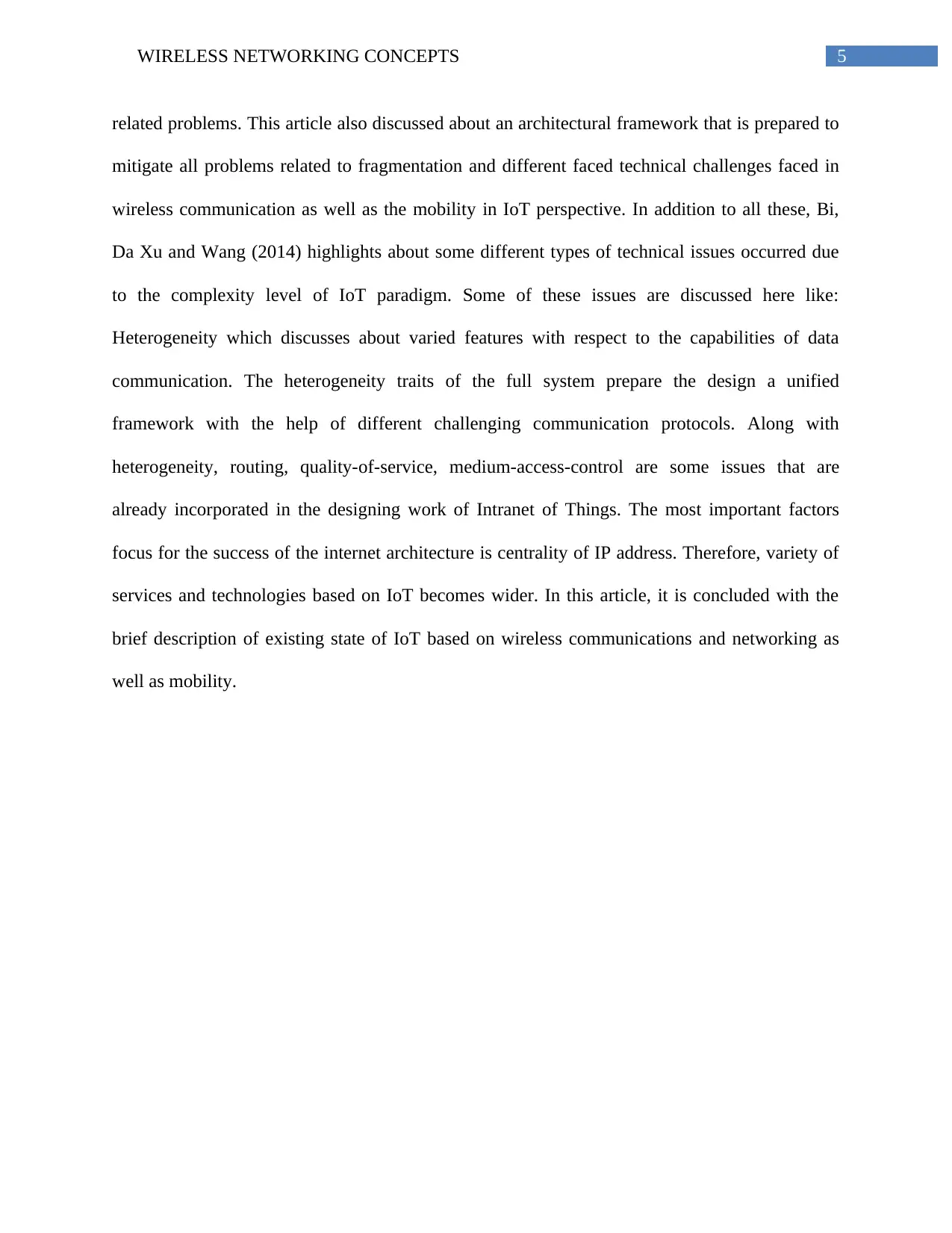
5WIRELESS NETWORKING CONCEPTS
related problems. This article also discussed about an architectural framework that is prepared to
mitigate all problems related to fragmentation and different faced technical challenges faced in
wireless communication as well as the mobility in IoT perspective. In addition to all these, Bi,
Da Xu and Wang (2014) highlights about some different types of technical issues occurred due
to the complexity level of IoT paradigm. Some of these issues are discussed here like:
Heterogeneity which discusses about varied features with respect to the capabilities of data
communication. The heterogeneity traits of the full system prepare the design a unified
framework with the help of different challenging communication protocols. Along with
heterogeneity, routing, quality-of-service, medium-access-control are some issues that are
already incorporated in the designing work of Intranet of Things. The most important factors
focus for the success of the internet architecture is centrality of IP address. Therefore, variety of
services and technologies based on IoT becomes wider. In this article, it is concluded with the
brief description of existing state of IoT based on wireless communications and networking as
well as mobility.
related problems. This article also discussed about an architectural framework that is prepared to
mitigate all problems related to fragmentation and different faced technical challenges faced in
wireless communication as well as the mobility in IoT perspective. In addition to all these, Bi,
Da Xu and Wang (2014) highlights about some different types of technical issues occurred due
to the complexity level of IoT paradigm. Some of these issues are discussed here like:
Heterogeneity which discusses about varied features with respect to the capabilities of data
communication. The heterogeneity traits of the full system prepare the design a unified
framework with the help of different challenging communication protocols. Along with
heterogeneity, routing, quality-of-service, medium-access-control are some issues that are
already incorporated in the designing work of Intranet of Things. The most important factors
focus for the success of the internet architecture is centrality of IP address. Therefore, variety of
services and technologies based on IoT becomes wider. In this article, it is concluded with the
brief description of existing state of IoT based on wireless communications and networking as
well as mobility.
⊘ This is a preview!⊘
Do you want full access?
Subscribe today to unlock all pages.

Trusted by 1+ million students worldwide
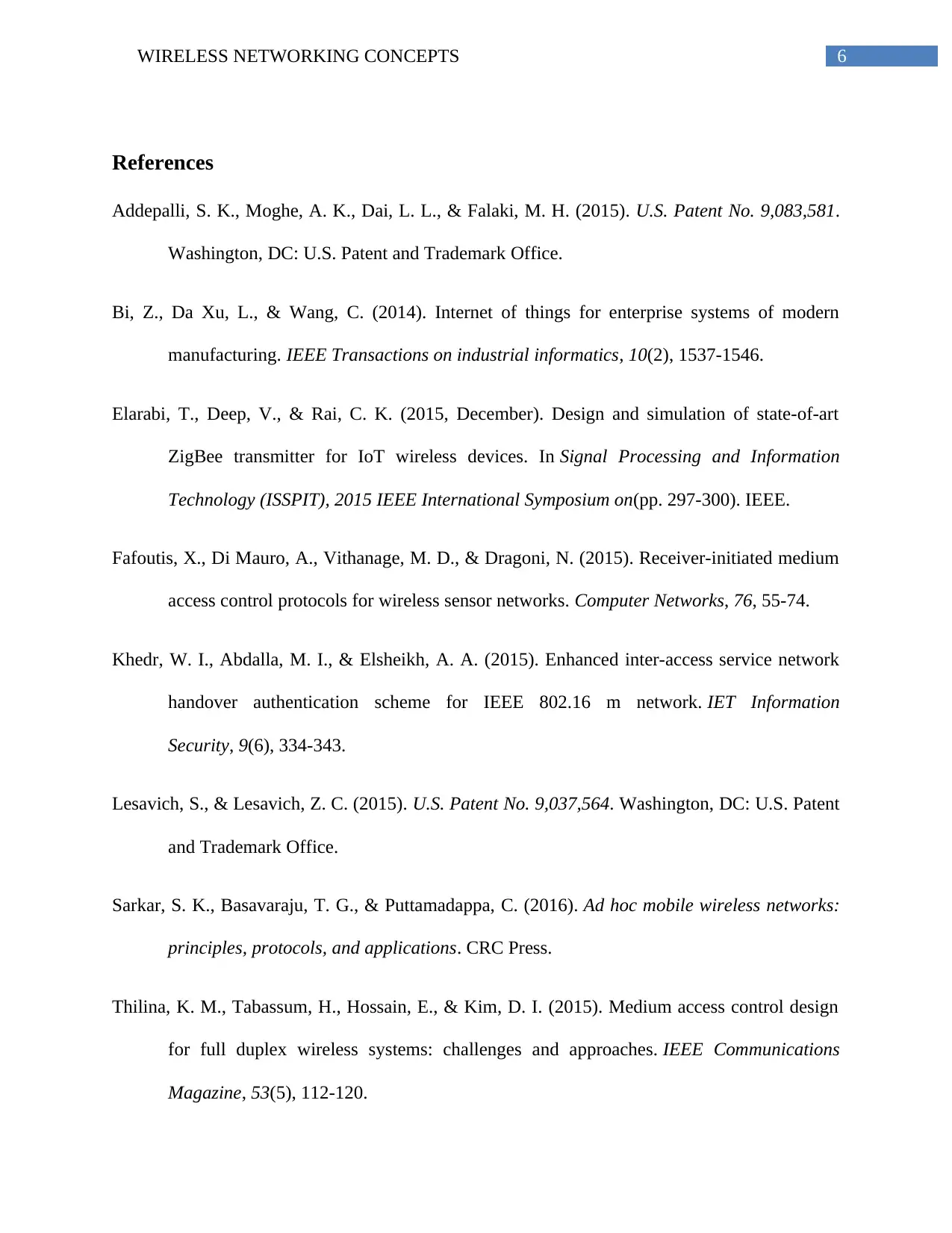
6WIRELESS NETWORKING CONCEPTS
References
Addepalli, S. K., Moghe, A. K., Dai, L. L., & Falaki, M. H. (2015). U.S. Patent No. 9,083,581.
Washington, DC: U.S. Patent and Trademark Office.
Bi, Z., Da Xu, L., & Wang, C. (2014). Internet of things for enterprise systems of modern
manufacturing. IEEE Transactions on industrial informatics, 10(2), 1537-1546.
Elarabi, T., Deep, V., & Rai, C. K. (2015, December). Design and simulation of state-of-art
ZigBee transmitter for IoT wireless devices. In Signal Processing and Information
Technology (ISSPIT), 2015 IEEE International Symposium on(pp. 297-300). IEEE.
Fafoutis, X., Di Mauro, A., Vithanage, M. D., & Dragoni, N. (2015). Receiver-initiated medium
access control protocols for wireless sensor networks. Computer Networks, 76, 55-74.
Khedr, W. I., Abdalla, M. I., & Elsheikh, A. A. (2015). Enhanced inter-access service network
handover authentication scheme for IEEE 802.16 m network. IET Information
Security, 9(6), 334-343.
Lesavich, S., & Lesavich, Z. C. (2015). U.S. Patent No. 9,037,564. Washington, DC: U.S. Patent
and Trademark Office.
Sarkar, S. K., Basavaraju, T. G., & Puttamadappa, C. (2016). Ad hoc mobile wireless networks:
principles, protocols, and applications. CRC Press.
Thilina, K. M., Tabassum, H., Hossain, E., & Kim, D. I. (2015). Medium access control design
for full duplex wireless systems: challenges and approaches. IEEE Communications
Magazine, 53(5), 112-120.
References
Addepalli, S. K., Moghe, A. K., Dai, L. L., & Falaki, M. H. (2015). U.S. Patent No. 9,083,581.
Washington, DC: U.S. Patent and Trademark Office.
Bi, Z., Da Xu, L., & Wang, C. (2014). Internet of things for enterprise systems of modern
manufacturing. IEEE Transactions on industrial informatics, 10(2), 1537-1546.
Elarabi, T., Deep, V., & Rai, C. K. (2015, December). Design and simulation of state-of-art
ZigBee transmitter for IoT wireless devices. In Signal Processing and Information
Technology (ISSPIT), 2015 IEEE International Symposium on(pp. 297-300). IEEE.
Fafoutis, X., Di Mauro, A., Vithanage, M. D., & Dragoni, N. (2015). Receiver-initiated medium
access control protocols for wireless sensor networks. Computer Networks, 76, 55-74.
Khedr, W. I., Abdalla, M. I., & Elsheikh, A. A. (2015). Enhanced inter-access service network
handover authentication scheme for IEEE 802.16 m network. IET Information
Security, 9(6), 334-343.
Lesavich, S., & Lesavich, Z. C. (2015). U.S. Patent No. 9,037,564. Washington, DC: U.S. Patent
and Trademark Office.
Sarkar, S. K., Basavaraju, T. G., & Puttamadappa, C. (2016). Ad hoc mobile wireless networks:
principles, protocols, and applications. CRC Press.
Thilina, K. M., Tabassum, H., Hossain, E., & Kim, D. I. (2015). Medium access control design
for full duplex wireless systems: challenges and approaches. IEEE Communications
Magazine, 53(5), 112-120.
Paraphrase This Document
Need a fresh take? Get an instant paraphrase of this document with our AI Paraphraser
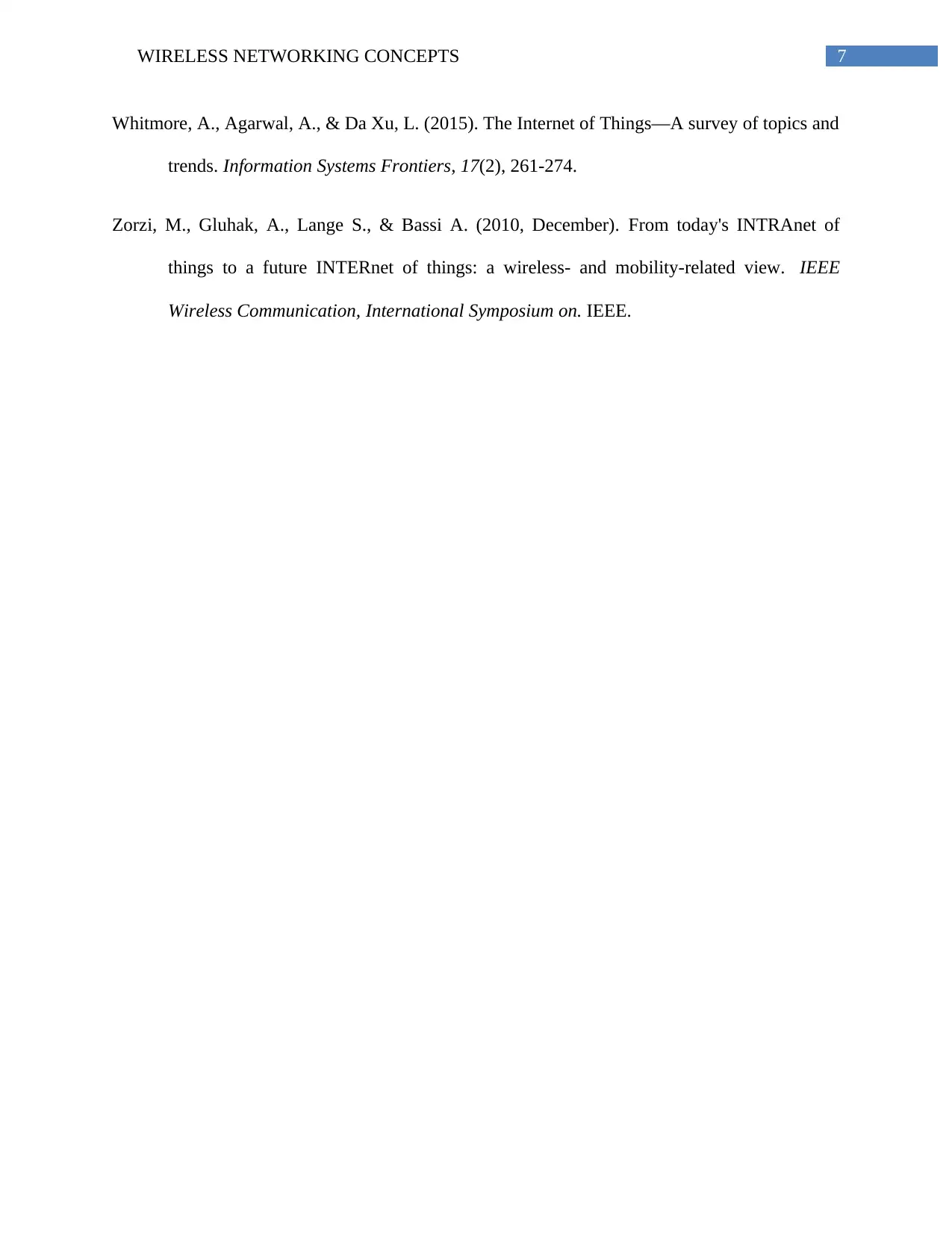
7WIRELESS NETWORKING CONCEPTS
Whitmore, A., Agarwal, A., & Da Xu, L. (2015). The Internet of Things—A survey of topics and
trends. Information Systems Frontiers, 17(2), 261-274.
Zorzi, M., Gluhak, A., Lange S., & Bassi A. (2010, December). From today's INTRAnet of
things to a future INTERnet of things: a wireless- and mobility-related view. IEEE
Wireless Communication, International Symposium on. IEEE.
Whitmore, A., Agarwal, A., & Da Xu, L. (2015). The Internet of Things—A survey of topics and
trends. Information Systems Frontiers, 17(2), 261-274.
Zorzi, M., Gluhak, A., Lange S., & Bassi A. (2010, December). From today's INTRAnet of
things to a future INTERnet of things: a wireless- and mobility-related view. IEEE
Wireless Communication, International Symposium on. IEEE.
1 out of 8
Related Documents
Your All-in-One AI-Powered Toolkit for Academic Success.
+13062052269
info@desklib.com
Available 24*7 on WhatsApp / Email
![[object Object]](/_next/static/media/star-bottom.7253800d.svg)
Unlock your academic potential
Copyright © 2020–2025 A2Z Services. All Rights Reserved. Developed and managed by ZUCOL.




